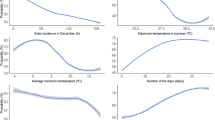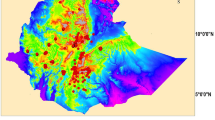Abstract
To determine the influence of nonclimatic factors on predicting the habitats of tree species and an assessment of climate change impacts over a broad geographical extent at about 1 km resolution, we investigated the predictive performance for models with climatic factors only (C-models) and models with climatic and nonclimatic factors (CN-models) using seven tree species in Japan that exhibit different ecological characteristics such as habitat preference and successional traits. Using a generalized additive model, the prediction performance was compared by prediction accuracy [area under the operating characteristic curve (AUC)], goodness of fit, and potential habitat maps. The results showed that the CN-models had higher predictive accuracy, higher goodness of fit, smaller empty habitats, and more finely defined borders of potential habitat than those of the C-models for all seven species. The degree of the total contribution of the nonclimatic variables to prediction performance also varied among the seven species. These results suggest that nonclimatic factors also play an important role in predicting species occurrence when measured to this extent and resolution, that the magnitude of model improvement is larger for species with specific habitat preferences, and that the C-models cannot predict the land-related habitats that exist for almost all species. Climate change impacts were overestimated by C-models for all species. Therefore, C-model outcomes may lead to locally ambiguous assessment of the impact of climate change on species distribution. CN-models provide a more accurate and detailed assessment for conservation planning.


Similar content being viewed by others
References
Armonies W, Reise K (2003) Empty habitat in coastal sediments for populations of macrozoobenthos. Helgoland Mar Res 56:276–287
Braun-Blanquet J (1964) Pflanzensoziologie. Grundzüge der vegetationuskunde. 3 Aufl. Springer, Wien
Coudun C, Gégout J (2007) Quantitative prediction of the distribution and abundance of Vaccinium myrtillus with climatic and edaphic factors. J Veg Sci 18:517–524
Coudun C, Gégout J, Piedallu C, Rameau J (2006) Soil nutritional factors improve models of plant species distribution: an illustration with Acer campestre (l.) in france. J Biogeogr 33:1750–1763
General Development Bureau, Economic Planning Agency of Japan (1967–1978) Land classification maps, 47 volumes
Geographical Survay Institute (2000) Digital map 50 m grid (elevation). Nippon-III. Japan Map Center, Tokyo
Geographical Survay Institute (2001a) Digital map 50 m grid (elevation). Nippon-I. Japan Map Center, Tokyo
Geographical Survay Institute (2001b) Digital map 50 m grid (elevation). Nippon-II. Japan Map Center, Tokyo
Geological Survey of Japan (2010) Seamless digital geological map of Japan 1: 200,000. 1 Feb 2010 version. Research Information Database DB084, Geological Survey of Japan, National Institute of Advanced Industrial Science and Technology
Guisan A, Zimmermann NE (2000) Predictive habitat distribution models in ecology. Ecol Model 135:147–186
Heikkinen RK, Luoto M, Araújo MB, Virkkala R, Thuiller W, Sykes MT (2006) Methods and uncertainties in bioclimatic envelope modelling under climate change. Prog Phys Geog 30:751
Horikawa M, Tsuyama I, Matsui T, Kominami Y, Tanaka N (2009) Assessing the potential impacts of climate change on the alpine habitat suitability of Japanese stone pine. Landsc Ecol 24:115–128
Huston M (1994) Biological diversity. Cambridge University Press, Cambridge
Ibáñez I, Silander JA, Wilson AM, LaFleur N, Tanaka N, Tsuyama I (2009) Multivariate forecasts of potential distributions of invasive plant species. Ecol Appl 19:359–375
IPCC (2007a) Climate change 2007: impacts, adaptation and vulnerability. Contribution of Working Group II to the fourth assessment report of the Intergovernmental Panel on Climate Change. Cambridge University Press, Cambridge
IPCC (2007b) Climate change 2007: the physical science basis. Contribution of Working Group I to the fourth assessment report of the Intergovernmental Panel on Climate Change. Cambridge University Press, Cambridge
Iverson LR, Prasad AM (1998) Predicting abundance of 80 tree species following climate change in the eastern united states. Ecol Monogr 68:465–485
Japan Botanical History Editing Committee (2009) Japan botanical history, vol 1. Japan Forestry Investigation Committee, Tokyo
Japan Meteorological Agency (1996) Climate normals for Japan. Japan Meteorological Business Support Center, Tokyo
Japan Meteorological Agency (2004) MRI-RCM20. Global Environment and Marine Department of Japan Meteorological Agency, Tokyo
Kira T (1991) Forest ecosystems of east and southeast Asia in a global perspective. Ecol Res 6:185–200
Luoto M, Heikkinen RK (2008) Disregarding topographical heterogeneity biases species turnover assessments based on bioclimatic models. Glob Change Biol 14:483–494
Luoto M, Heikkinen RK, Pöyry J, Saarinen K (2006) Determinants of the biogeographical distribution of butterflies in boreal regions. J Biogeogr 33:1764–1778
Luoto M, Virkkala R, Heikkinen RK (2007) The role of land cover in bioclimatic models depends on spatial resolution. Glob Ecol Biogeogr 16:34–42
Marini L, Prosser F, Klimek S, Marrs RH (2008) Water-energy, land-cover and heterogeneity drivers of the distribution of plant species richness in a mountain region of the european alps. J Biogeogr 35:1826–1839
Matsui T, Yagihashi T, Nakaya T, Taoda H, Yoshinaga S, Daimaru H, Tanaka N (2004) Probability distributions, vulnerability and sensitivity in Fagus crenata forests following predicted climate changes in japan. J Veg Sci 15:605–614
Ohsawa M (1993) Latitudinal pattern of mountain vegetation zonation in southern and eastern asia. J Veg Sci 4:13–18
Pearson RG, Dawson TP (2003) Predicting the impacts of climate change on the distribution of species: are bioclimate envelope models useful? Glob Ecol Biogeogr 12:361–371
Pearson RG, Dawson TP, Liu C (2004) Modelling species distributions in Britain: a hierarchical integration of climate and land-cover data. Ecography 27:285–298
R Development Core Team (2009) R: a language and environment for statistical computing. Vienna, Austria. http://www.R-project.org
Randin CF, Engler R, Normand S, Zappa M, Zimmermann NE, Pearman PB, Vittoz P, Thuiller W, Guisan A (2009) Climate change and plant distribution: local models predict high-elevation persistence. Glob Change Biol 15:1557–1569
Robin X, Turck N, Hainard A, Tiberti N, Lisacek F, Sanchez J, Müller M (2011) pROC: an open-source package for R and S+ to analyze and compare ROC curves. BMC Bioinforma 12:77
Stefanescu C, Herrando S, Paŕamo F (2004) Butterfly species richness in the north-west mediterranean basin: the role of natural and human-induced factors. J Biogeogr 31:905–915
Swets JA (1988) Measuring the accuracy of diagnostic systems. Science 240:1285–1293
Tanaka N (2007) PRDB (Phytosociological reléve data base). Environmental change impact team, forestry and forest products research institute. http://www.ffpri.affrc.go.jp/labs/prdb/index.html
The Plant List (2010) Version 1. http://www.theplantlist.org/. Accessed 1 Jan 2011
Thuiller W, Araújo MB, Lavorel S (2004) Do we need land-cover data to model species distributions in europe? J Biogeogr 31:353–361
Thuiller W, Lavorel S, Araújo MB, Sykes MT, Prentice IC (2005) Climate change threats to plant diversity in europe. Proc Natl Acad Sci 102:8245
Thuiller W, Vayreda J, Joan Pino SS, Lavorel S, Gracia C (2003) Large-scale environmental correlates of forest tree distributions in Catalonia (NE Spain). Glob Ecol Biogeogr 12:313–325
Tsuyama I, Nakao I, Matsui T, Higa M, Horikawa M, Kominami Y, Tanaka N (2011) Climatic controls of a keystone understory species, Sasamorpha borealis, and an impact assessment of climate change in Japan. Ann For Sci 68:689–699
Virkkala R, Luoto M, Heikkinen RK, Leikola N (2005) Distribution patterns of boreal marshland birds: modelling the relationships to land cover and climate. J Biogeogr 32:1957–1970
Virkkala R, Marmion M, Heikkinen RK, Thuiller W, Luoto M (2010) Predicting range shifts of northern bird species: influence of modelling technique and topography. Acta Oecol 36:269–281
Wiens JA (1989) Spatial scaling in ecology. Funct Ecol 3:385–397
Wood SN (2006) Generalized additive models. An introduction with R. Chapman and Hall/CRC, Boca Raton
Yokozawa M, Goto S, Hayashi Y, Seino H (2003) Mesh climate change data for evaluating climate change impacts in Japan under gradually increasing atmospheric CO2 concentration. J Agric Meteorol 59:117–130
Acknowledgments
This study was funded by a program of the Global Environmental Research of Japan (S-4 and S-8), the Ministry of the Environment.
Author information
Authors and Affiliations
Corresponding author
Electronic supplementary material
Below is the link to the electronic supplementary material
Fig. A. 1. Geographic distributions for the four climatic (current and future), four topological, and two geological variables. Regional Climate Model with a spatial resolution of 20 km × 20 km (Japan Meteorological Agency. 2004) for 2081–2100 was used as future climate scenario in this study
Fig. A. 2. Current distribution (I), differences in predicted potential habitats (II, III, IV, V), and changes in habitat types (VI) between climate (C)- and climate–nonclimate (CN)-models under current and future climate scinarios (2081–2100). Maps II and IV were derived from C-models; maps III and V were derived from CN-models
Rights and permissions
About this article
Cite this article
Higa, M., Tsuyama, I., Nakao, K. et al. Influence of nonclimatic factors on the habitat prediction of tree species and an assessment of the impact of climate change. Landscape Ecol Eng 9, 111–120 (2013). https://doi.org/10.1007/s11355-011-0183-y
Received:
Revised:
Accepted:
Published:
Issue Date:
DOI: https://doi.org/10.1007/s11355-011-0183-y




